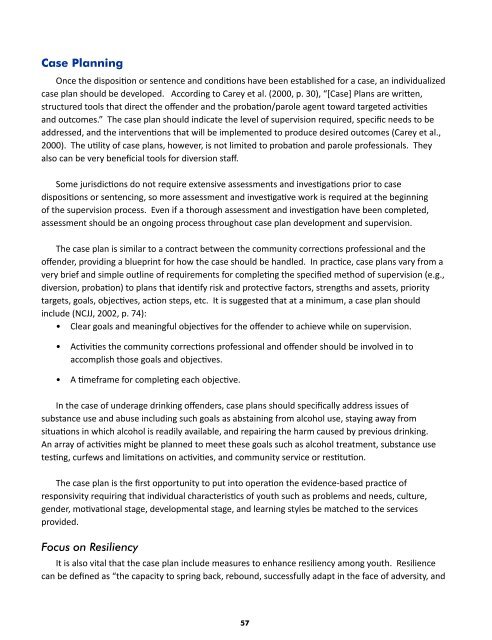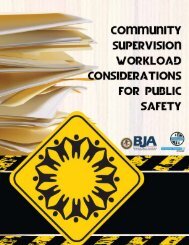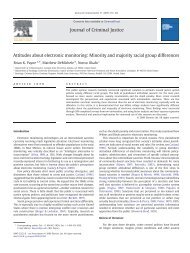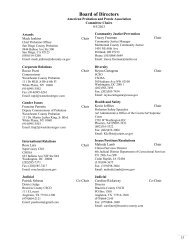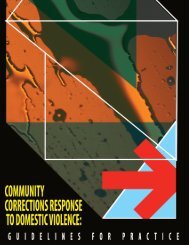Intervention Principles and Practice Guidelines for - Underage ...
Intervention Principles and Practice Guidelines for - Underage ...
Intervention Principles and Practice Guidelines for - Underage ...
You also want an ePaper? Increase the reach of your titles
YUMPU automatically turns print PDFs into web optimized ePapers that Google loves.
Case Planning<br />
Once the disposition or sentence <strong>and</strong> conditions have been established <strong>for</strong> a case, an individualized<br />
case plan should be developed. According to Carey et al. (2000, p. 30), “[Case] Plans are written,<br />
structured tools that direct the offender <strong>and</strong> the probation/parole agent toward targeted activities<br />
<strong>and</strong> outcomes.” The case plan should indicate the level of supervision required, specific needs to be<br />
addressed, <strong>and</strong> the interventions that will be implemented to produce desired outcomes (Carey et al.,<br />
2000). The utility of case plans, however, is not limited to probation <strong>and</strong> parole professionals. They<br />
also can be very beneficial tools <strong>for</strong> diversion staff.<br />
Some jurisdictions do not require extensive assessments <strong>and</strong> investigations prior to case<br />
dispositions or sentencing, so more assessment <strong>and</strong> investigative work is required at the beginning<br />
of the supervision process. Even if a thorough assessment <strong>and</strong> investigation have been completed,<br />
assessment should be an ongoing process throughout case plan development <strong>and</strong> supervision.<br />
The case plan is similar to a contract between the community corrections professional <strong>and</strong> the<br />
offender, providing a blueprint <strong>for</strong> how the case should be h<strong>and</strong>led. In practice, case plans vary from a<br />
very brief <strong>and</strong> simple outline of requirements <strong>for</strong> completing the specified method of supervision (e.g.,<br />
diversion, probation) to plans that identify risk <strong>and</strong> protective factors, strengths <strong>and</strong> assets, priority<br />
targets, goals, objectives, action steps, etc. It is suggested that at a minimum, a case plan should<br />
include (NCJJ, 2002, p. 74):<br />
• Clear goals <strong>and</strong> meaningful objectives <strong>for</strong> the offender to achieve while on supervision.<br />
• Activities the community corrections professional <strong>and</strong> offender should be involved in to<br />
accomplish those goals <strong>and</strong> objectives.<br />
• A timeframe <strong>for</strong> completing each objective.<br />
In the case of underage drinking offenders, case plans should specifically address issues of<br />
substance use <strong>and</strong> abuse including such goals as abstaining from alcohol use, staying away from<br />
situations in which alcohol is readily available, <strong>and</strong> repairing the harm caused by previous drinking.<br />
An array of activities might be planned to meet these goals such as alcohol treatment, substance use<br />
testing, curfews <strong>and</strong> limitations on activities, <strong>and</strong> community service or restitution.<br />
The case plan is the first opportunity to put into operation the evidence-based practice of<br />
responsivity requiring that individual characteristics of youth such as problems <strong>and</strong> needs, culture,<br />
gender, motivational stage, developmental stage, <strong>and</strong> learning styles be matched to the services<br />
provided.<br />
Focus on Resiliency<br />
It is also vital that the case plan include measures to enhance resiliency among youth. Resilience<br />
can be defined as “the capacity to spring back, rebound, successfully adapt in the face of adversity, <strong>and</strong><br />
57


